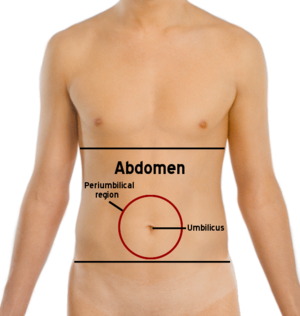Abdominal migraine facts for kids
Abdominal migraine (AM) is a type of migraine that causes severe pain in the tummy, also known as the abdomen. The pain usually happens around the belly button, which doctors call the periumbilical area.
AM is most common in children, often starting around age 7. However, younger and older kids can also get it. Usually, abdominal migraines stop by the time children become teenagers. But, kids who have had AM might be more likely to get migraine headaches when they are adults. Sometimes, adults can also experience abdominal migraines.
Abdominal migraine causes paroxysmal attacks. This means the attacks happen suddenly, and they come back again and again. These attacks can last from 1 hour to 72 hours, but they usually last less than 6 hours. Girls get abdominal migraines about one-third more often than boys.
Along with bad tummy pain, abdominal migraines can cause other symptoms. People with AM usually have at least two of these: nausea (feeling sick to your stomach), vomiting (throwing up), not wanting to eat, headache, photophobia (being bothered by bright lights), and pallor (pale skin).
AM is more common in children whose mothers have had migraine headaches. This suggests that AM might be genetic. This means it can be passed down from parents to their children through their genes.
What are the Symptoms of Abdominal Migraine?
Abdominal migraines can cause many different symptoms. A person having an AM might have all of these, or just a few.
- Pain in the tummy that lasts from 1 hour to 72 hours.
- Not wanting to eat (loss of appetite).
- Nausea (feeling like throwing up).
- Vomiting (throwing up).
- Yawning a lot.
- Feeling very tired and having no energy (listlessness).
- Feeling very sleepy (drowsiness).
- Pale skin (pallor). Your skin looks lighter than usual.
- Flushing or blushing of the skin. This is when your face, neck, or chest suddenly turns red. It happens when your body makes more adrenaline. This hormone makes your heart beat faster and sends more blood through your blood vessels. The blood vessels also get wider.
- Dark circles under both eyes (periorbital dark circles).
How Do Doctors Diagnose Abdominal Migraine?
To figure out if someone has abdominal migraine, a doctor first learns about the patient's health history. This includes all past medical problems and treatments. The doctor also asks about the family's health. This is because some medical problems can be inheritable. This means they can be passed down from parents to children, possibly due to problems in the family's genes. Most people with abdominal migraines have family members, especially mothers, who have also had migraines.
Doctors use specific guidelines to diagnose abdominal migraine. Here are some important points:
- The person must have sudden attacks of strong pain around the belly button. This pain must last for 1 hour or more.
- The person should feel healthy between attacks. These healthy periods can last for weeks or even months.
- The pain must be strong enough to make it hard to do normal daily activities.
- During the attacks, the person must have at least two of these symptoms:
- Not wanting to eat or being unable to eat.
- Nausea (feeling sick to your stomach).
- Vomiting (throwing up).
- Headache.
- Photophobia (light hurts their eyes).
- Pallor (pale skin).
- Doctors must make sure there are no other medical problems causing these symptoms.
- A person needs to have had at least two or more attacks of these symptoms in the last year to be diagnosed with abdominal migraine.
What Other Problems Might Look Like Abdominal Migraine?
Before saying for sure that someone has abdominal migraine, a doctor must check for differential diagnoses. These are other medical problems that can cause similar symptoms to AM. The doctor needs to make sure the patient doesn't have one of these other problems instead:
- Giardia lamblia: This is a tiny parasite that can cause an infection in a person's tummy and gut (their gastrointestinal system).
- Lead poisoning: This happens when too much lead builds up in the body.
- A tumor: This is an unusual growth of cells.
- A peptic ulcer: This is a sore that forms on the lining of the stomach or the first part of the small intestine.
- Mesenteric adenitis: This is when the lymph nodes (small glands that fight infection) in the tummy become swollen.
- Irritable bowel syndrome: This is a common problem that affects the large intestine, causing tummy pain, bloating, and changes in bowel habits.
- Constipation: This means having difficulty passing stool or having bowel movements less often than usual.
- Superior mesenteric artery (SMA) syndrome: This is a rare condition where a blood vessel presses on part of the small intestine.
- Splenoptosis or 'Wandering spleen': This is a rare condition where the spleen moves from its normal position.
- Recurrent pancreatitis: This is when the pancreas (an organ that helps with digestion) gets inflamed over and over again.


